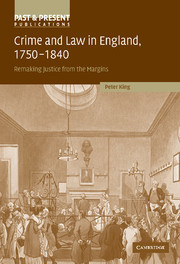Book contents
- Frontmatter
- Contents
- Preface
- List of figures
- List of tables
- 1 Shaping and remaking justice from the margins. The courts, the law and patterns of lawbreaking 1750–1840
- Part I Juveniles
- 2 The rise of juvenile delinquency in England 1780–1840: changing patterns of perception and prosecution
- 3 The punishment of juvenile offenders in the English courts 1780–1830. Changing attitudes and policies
- 4 The making of the reformatory. The development of informal reformatory sentences for juvenile offenders 1780–1830
- Part II Gender
- Part III Non-lethal violence
- Part IV The attack on customary rights
- Index
- Past and Present Publications
3 - The punishment of juvenile offenders in the English courts 1780–1830. Changing attitudes and policies
Published online by Cambridge University Press: 25 July 2009
- Frontmatter
- Contents
- Preface
- List of figures
- List of tables
- 1 Shaping and remaking justice from the margins. The courts, the law and patterns of lawbreaking 1750–1840
- Part I Juveniles
- 2 The rise of juvenile delinquency in England 1780–1840: changing patterns of perception and prosecution
- 3 The punishment of juvenile offenders in the English courts 1780–1830. Changing attitudes and policies
- 4 The making of the reformatory. The development of informal reformatory sentences for juvenile offenders 1780–1830
- Part II Gender
- Part III Non-lethal violence
- Part IV The attack on customary rights
- Index
- Past and Present Publications
Summary
Much has been written about the extensive debates on the treatment of juvenile offenders that characterised the 1830s, 1840s and early 1850s — debates that had an important influence on the major mid-century legislative changes which both established reformatories as the central plank in punishment policies, and transferred juvenile larceny trials into the summary courts. However, the earlier development of attitudes towards the punishment of juvenile delinquents has been relatively neglected and has usually been regarded by historians mainly as a prelude to the broader investigations that took place in the 1830s and 1840s. This is somewhat surprising since the previous period, and in particular the 1810s and 1820s, witnessed not only the emergence of juvenile delinquency as a major focus of social anxiety, but also a huge rise in the number of juvenile offenders being dealt with by the courts. Although the extensive debates of the 1810s and 1820s did not immediately lead to significant legislative change, they undoubtedly affected penal policies on the ground.
There was considerable room for non-legislative innovation and penal change within the criminal justice system of the early nineteenth century. Judges, jurors and those involved in the pardoning process could choose between a wide range of potential outcomes in their dealings with juvenile offenders. They could also set up, or adapt for penal purposes, various voluntary-sector penal institutions (as the next chapter will indicate).
- Type
- Chapter
- Information
- Crime and Law in England, 1750–1840Remaking Justice from the Margins, pp. 114 - 141Publisher: Cambridge University PressPrint publication year: 2006



